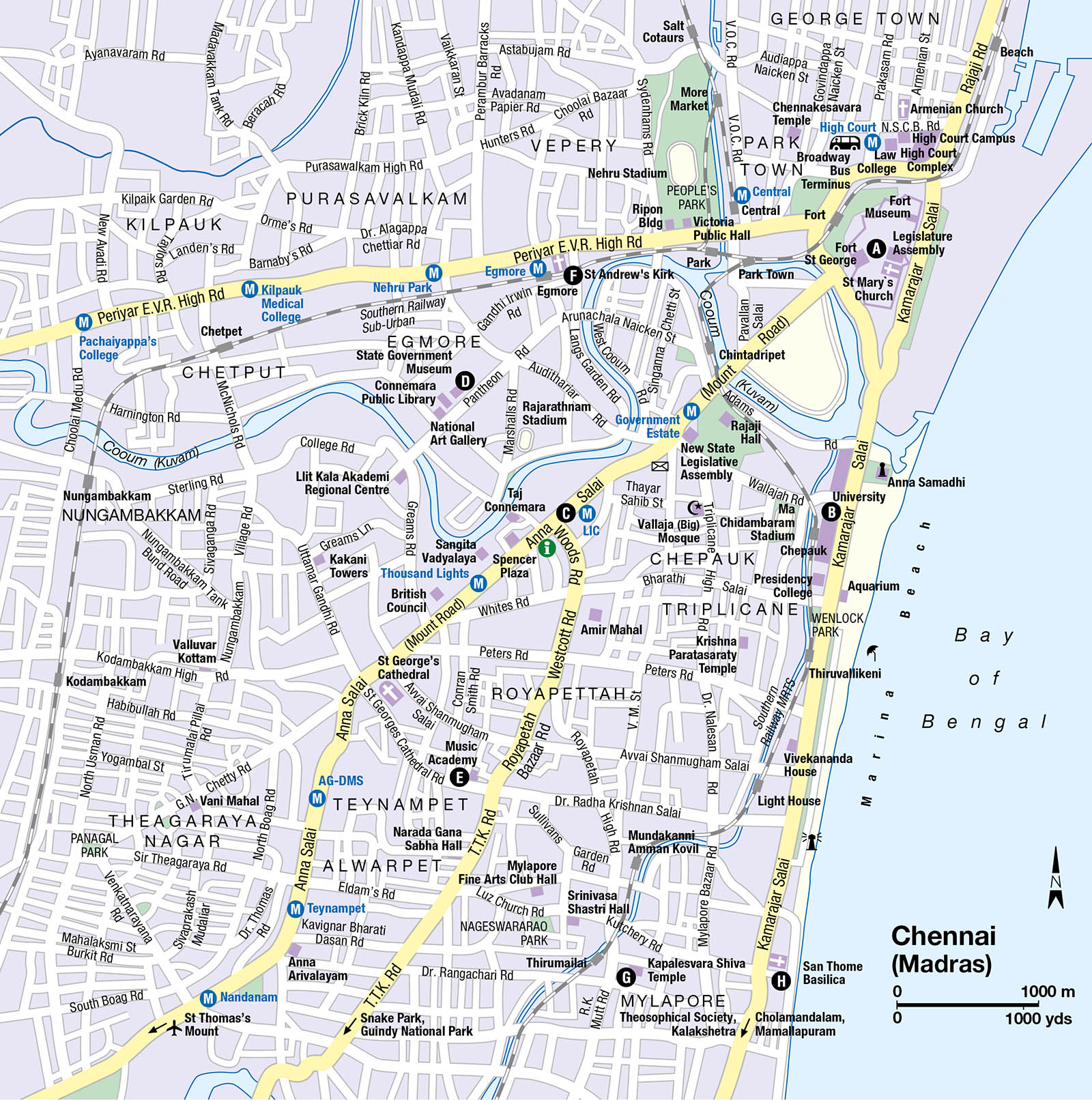The major metropolis of the South, Chennai – known as Madras until 1996 – is India’s fourth-largest city, home to around 7 million inhabitants (8.9 including the metropolitan area) and sprawling for miles along the coast of northern Tamil Nadu. The area has been inhabited since as early as the 1st century, but really came to prominence as a major port from the 1500s onwards. The Portuguese and the Dutch both had bases here, but it wasn’t until the arrival of the British East India Company in 1639 that the city began to take shape.
The city today is a curious mixture. While it retains the legacy of the British Raj, and is, in some ways, a conservative bastion in social and religious matters, it is also the Bollywood of South India and, simultaneously, a stronghold of traditional Tamil culture. There are churchyards, staid residential areas and prim gardens side by side with giant-size cut-outs of cinema heroes and heroines, painted in bright colours and dotted with flashing sequins.
As if this contrast were not enough, Chennai has reinvented itself over the last few years. Now one of the south’s booming software and call-centre hubs (rivalling Bengaluru and Hyderabad), the centre is sprouting glossy new high-rise buildings and shopping malls, patronised by the city’s middle class. Not quite so fortunate, however, are Chennai’s poor and lower castes, still greatly in evidence on the city streets.
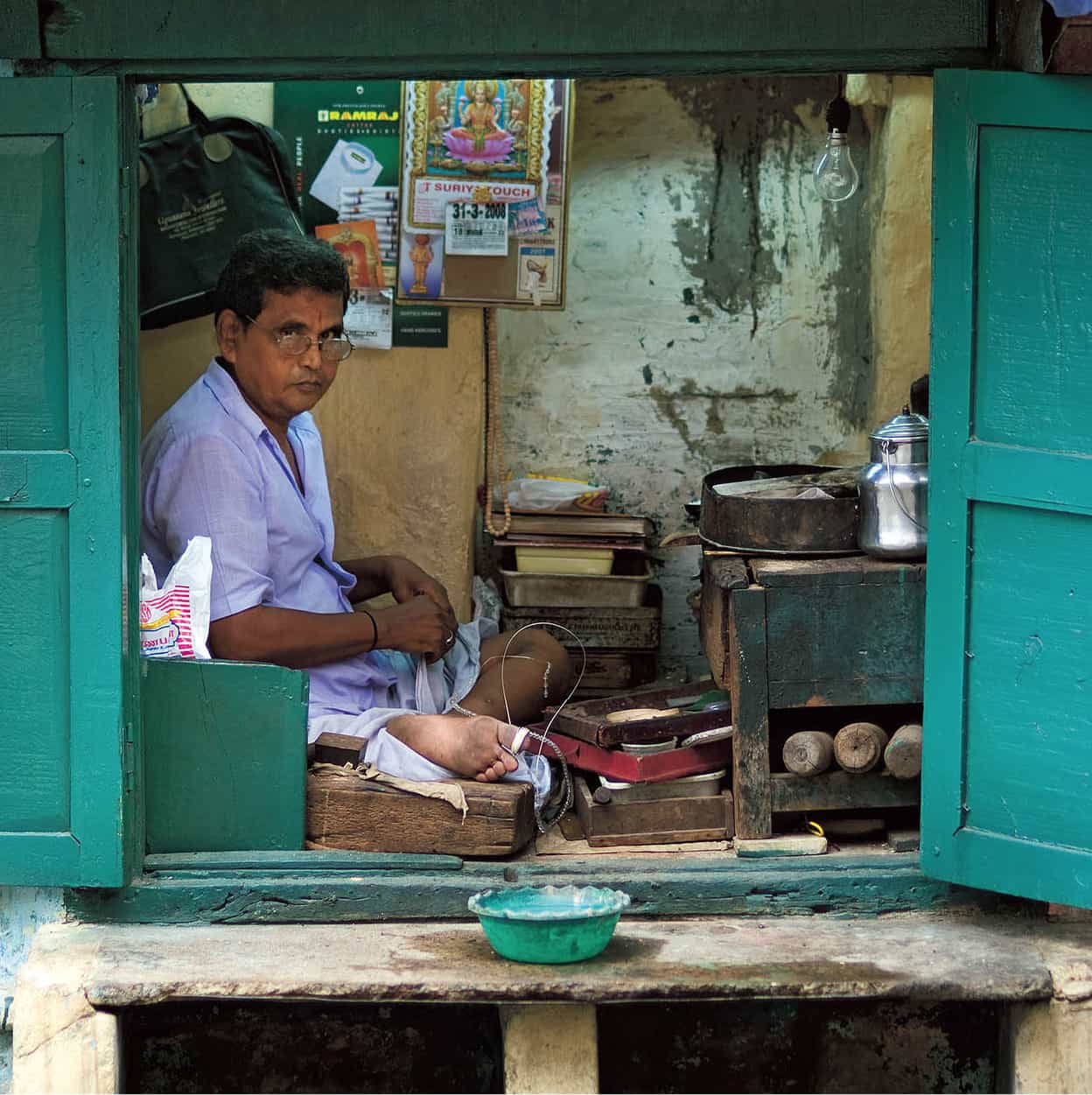
A Mylapore jeweller.
Britta Jaschinski/Apa Publications
Most of the city’s sights are easily reached from the city centre, which is also where most of the accommodation options are to be found. The colonial Fort area is just to the north of the city centre, while the wider, more open spaces tend to be found to the south, with a number of attractions, particularly for children, dotted along the scenic East Coast Road to Mamallapuram.
Climatically, this corner of India goes from hot to hotter and hottest, with relief brought by the northwest monsoon in June and July, and the southeast monsoon in November and December, when sea breezes bring a cool freshness to the land and the beaches are beautiful in the early hours and late evenings. The sea here, on the east coast – romantically named the Coromandel Coast – is not as inviting for the swimmer as India’s western Malabar coast (the wicked undertow making it very dangerous), but the city beaches hum with groups of picnickers and strolling families. At night, lights from fishing boats can be seen glowing over the dark waters.
Transport to and from Chennai
Chennai is one of India’s major international airports, as well as an important hub for internal flights on a variety of domestic airlines.
There are two main railway stations, Chennai Central and Chennai Egmore, so check on your ticket where your train departs from. Trains run from Chennai to: Bengaluru (9–13 daily; 5–7hrs); Delhi (4–5 daily; 27–36hrs); Hyderabad (3–4 daily; 12–14hrs); Madurai (11–18 daily; 8–12hrs); Thanjavur (7–10 daily; 6–9hrs); Tirupati (3 daily; 3–4hrs).
Long-distance buses, including those to Mamallapuram, depart from Mofussil Bus Terminus in southern Chennai – one of the largest in Asia, it is well-run and clearly signposted. In reality visitors will probably only use it to reach Mamallapuram (2.5 hrs, over 20 departures daily).
Chennai is also the gateway to Tamil Nadu, and makes an excellent introduction to Tamil culture, food, customs and people. Vegetarian food is available in restaurants serving delicious hot ‘meals’ with boiled rice, lentil curries and tiny portions of vegetables, while the famous fried dosa and steamed idli have come to be identified with Tamil Nadu.
The British East India Company established one of its earliest seats of power in India in the former Madras, and the construction of Fort St George A [map] was begun around 1640 – making it the oldest colonial structure in the country. The fort was often attacked by Indian and French forces, yet it continued to expand. Today its buildings house the Tamil Nadu Government Secretariat and the Legislative Assembly. A feature of the East India Company architecture is the use of Madras chunam, a glittering whitewash of limestone mixed with crushed seashells. The chunam-coated walls of the buildings are dazzling.
Within the fort, a number of other early buildings still stand, of which St Mary’s Church (daily 9am–5pm; free) is the most interesting. It is the earliest English building surviving intact in India and the oldest Anglican church in Asia, consecrated in 1680. The interior of the church is whitewashed, but there are also elaborate carved wooden panels. The church was the venue for the marriage of Robert Clive, victor of the Battle of Plassey in 1759 – which marked the beginning of formal British rule in India.
Fact
Chennai has a large Christian population. The British occupation from the 17th century left an Anglo-Indian population. Though well integrated into Indian society, their religion, clothes and culture make them distinct.
The Fort St George Museum (Sat–Thu 9am–5pm), housed in what was built as the Public Exchange, gives a good overview of the early British colonial lifestyle. A marble statue of Cornwallis by Thomas Banks greets visitors, with various storehouses and the city’s first bank occupying the ground floor. The first floor, now a gallery of colonial portrait art, was once the coffee shop where merchants and officials met for gossip and trade. Other items on display include uniforms, coins, weapons and books. Perhaps the most intriguing artefact is Anstruther’s Cage, a small wooden box used by the Chinese to imprison a British army officer captured in 1840 during the First Opium War, who was subsequently kept in the cramped space for six months.
Other fort buildings of note include the Old Government House and the Banqueting Hall (Rajaji Hall), built for the governor’s official entertainment during the Clive period. The architectural style drew inspiration from the classical Greeks and Romans – with Doric, Corinthian and Tuscan pillars, entablatures and friezes much in evidence.
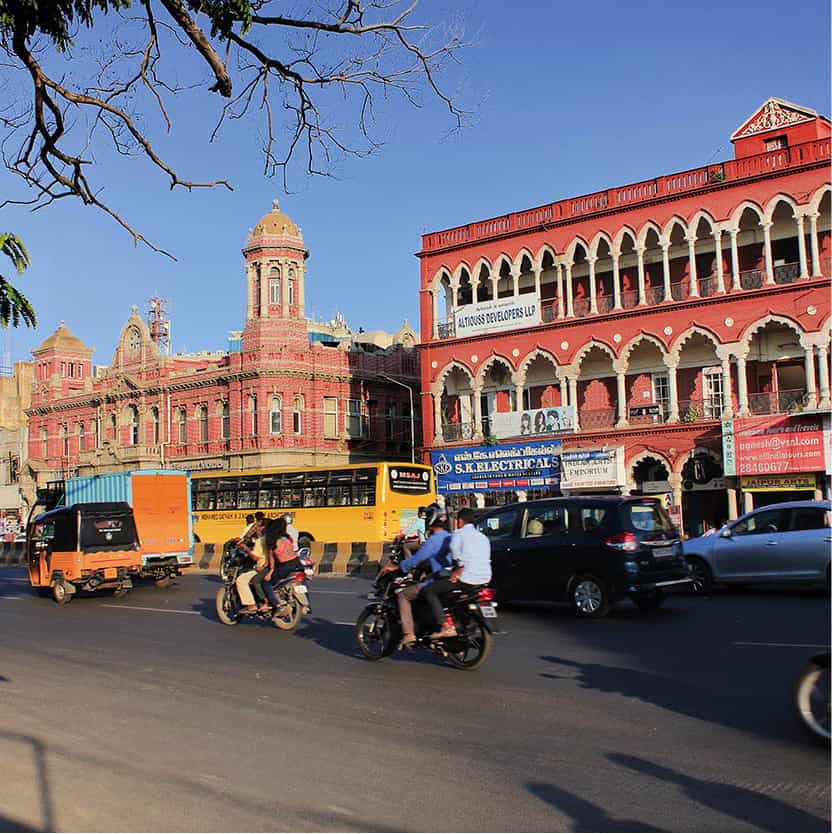
Anna Salai, previously Mount Road, Chennai.
Shutterstock
The Marina, extending almost 13km (8 miles), is a wide, sandy – and in places rather dirty – beach and one of Chennai’s most popular meeting places. A 2010 renovation and litter drive went a long way to tidying up the beachfront. It’s worth coming down here at sunset to witness the crowds and the entertainment – Elliot’s Beach in Besant Nagar is a slightly more low-key alternative. Facing the sea are the 19th-century Presidency College and the Senate House of the University B [map]. The university building and its grounds are noted examples of the Indo-Islamic style popular in Indian public architecture in the late 19th century.
Opposite the university is the Anna Samadhi, a large marble-clad lotus commemorating C.N. Annadurai, who led the Dravidian movement to political power and changed the social and political structure of Tamil Nadu. Beside it is a memorial to M.G. Ramachandran, a much-loved film star and chief minister.
The “Season”
The most popular classical music and dance festival in India is the Chennai ‘season’, an annual event that began 65 years ago, when the Chennai Music Academy was founded and began organising conferences at which various aspects of Karnatak music and Bharata-natyam were the chief topics of discussion. The conferences were accompanied by day-long programmes comprising instrumental and vocal concerts and dance recitals. It is still held at the Academy today, running for three weeks from mid-December to early January. Artists consider it an honour to be invited to perform at its concerts, and devotees of South Indian music and dance come from all over the country to attend.
Several other art-promoting societies (sabhas) have sprung up in Chennai, and all now organise ‘seasons’ during the same period. They include the Tamil Isai Sangam, Brahma Gana Sabha, Narada Gana Sabha, Krishna Gana Sabha and the Mylapore Fine Arts Club. Listings of what’s on are published every day in The Hindu.
Finally, if you’re in the region any time in January, try to catch the annual Chennai Sangamam arts festival, which sees performances of south Indian folk music and dance, martial arts and street plays taking places at various open-air venues across the city; admission to all events is free.
Anna Salai C [map] (previously Mount Road) is Chennai’s main shopping street. Higginbotham’s, one of India’s best-known bookshops, is here. There are other bookshops worth checking out nearby: Landmark Books in Spencer Plaza is said to be one of Asia’s largest bookstores, while Giggles in the Connemara is recommended for its knowledgeable owner and eclectic stock.
Chennai is famous for its silk emporia where silk saris, scarves, and material for suiting and dresses are available by the yard. The Government-run Co-optex shops have an extensive range of fabrics, and Poompuhar, the Government Handicrafts Emporium, has good bronzes. Both these are on Anna Salai, along with a number of other state emporia. At the junction of Anna Salai and Binny Road is Spencer Plaza, an air-conditioned complex with a large number of different shops. On Binny Road itself is the Art Deco Taj Connemara hotel.
To the north of the busiest part of Anna Salai are many of the newer landmarks of the city, most of them 100–150 years old. On Pantheon Road, where the Pantheon was home to public entertainments in Arthur Wellesley’s (later the Duke of Wellington) day, is the magnificent, though dreadfully run-down, State Government Museum D [map] (www.govtmuseumchennai.org; Sat–Thu 9.30am–5pm). Established in 1846, it has one of the finest collections in the country including a rare collection of sculptures from Amaravati in Andhra Pradesh, belonging to the Buddhist period, 2nd century AD. The white limestone sculptured medallions and panels tell the story of the life of the Buddha. The Bronze Gallery has a superb collection of Chola bronzes (9th–13th century AD). Some are barely 4cm (1.5 ins) tall, while others measure over half a metre (1.5ft). All are iconographically sophisticated. The dancing Shivas, Durgas and Ganapatis and the famous Rama, Lakshmana and Sita group are the pride of the museum.
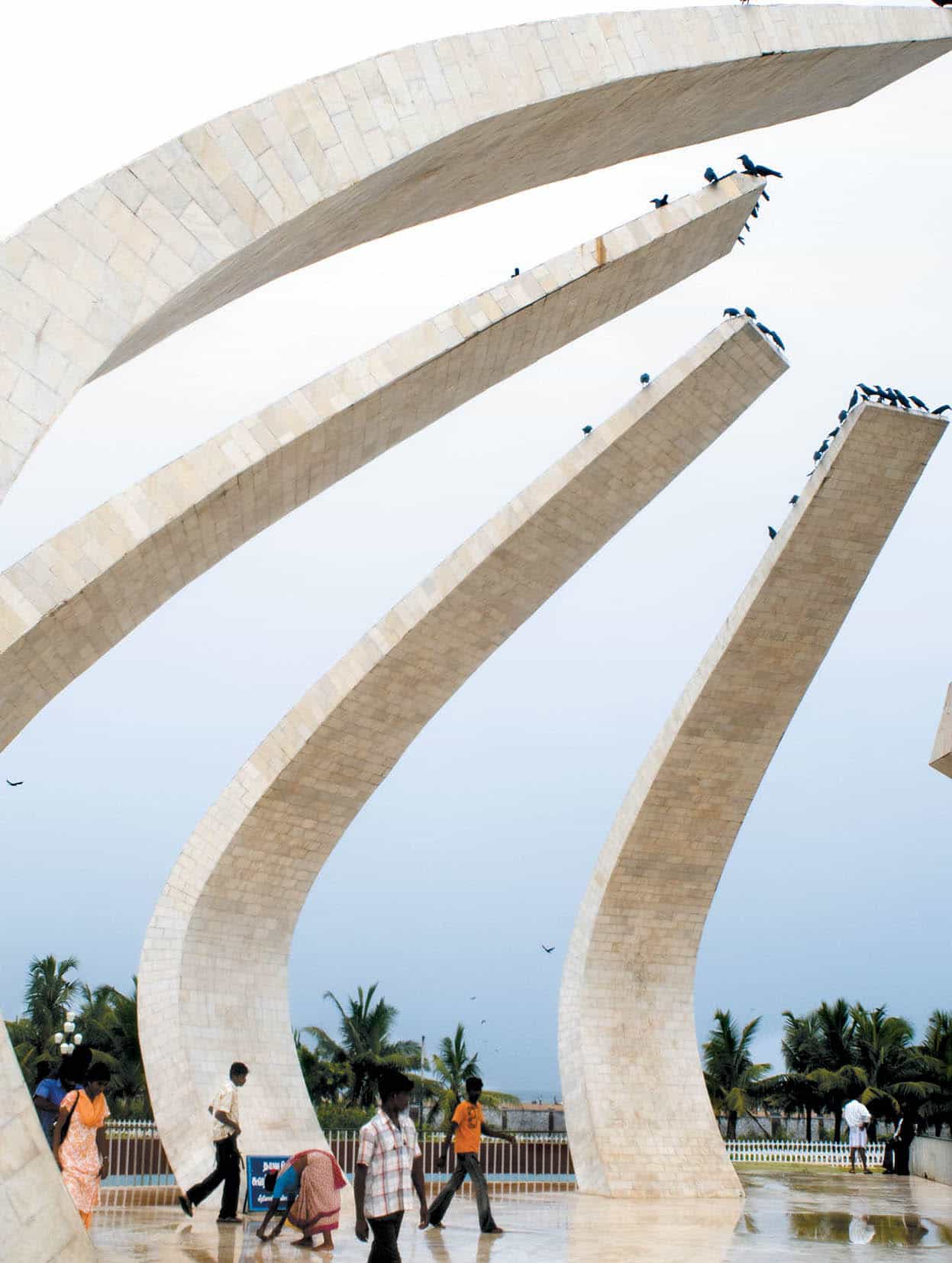
M.G. Ramachandran memorial.
David Abrahams/Apa Publications
Next door to the State Government Museum is the National Art Gallery (Sat–Thu 9.30am–5pm; admission included with State Government Museum), with a permanent exhibition of Indian painting. In the newer wings is a gallery of contemporary art where temporary shows are held. The nearby Connemara Public Library is one of the country’s four national libraries to which every book published in India must be sent.
In performing arts, of all the city’s concert halls, the Music Academy E [map] (www.musicacademymadras.in) is the most renowned. It puts on music and dance programmes by eminent artists for discerning audiences, which inspires the performers, whether of Karnatak music or Bharata-natyam, to memorable heights. Check out other venues, such as the Krishna Gana Sabha (www.krishnaganasabha.org), particularly during the Chennai Festival in December and January, when you can see performances by South India’s finest dancers and Karnatak musicians.
Beyond, at no. 601, is The Park hotel, set in what was once the city’s Gemini Film Studios, where a number of classic Tamil movies have been shot. Now a luxurious design hotel, its bar, club and rooftop pool are a magnet for Chennai’s young middle class looking to spend their call-centre salaries.
Egmore and George Town
Beyond the Government Museum is Egmore, once the Indian town that complemented the colonial town of Fort St George. Now a commercial centre, it has a number of interesting colonial buildings. Egmore Railway Station, the Chennai Medical College, the Ripon Building and Victoria Public Hall are all worth seeking out. Perhaps the most magnificent Indo-Saracenic complex in the city, however, is the High Court and Law College campus to the northeast of Egmore, bordering on George Town. Its large, ornately-domed towers are surmounted on chatris (pavilions), while the windows are given a characteristic arch striking a nice balance between imperial pomp and local architectural forms.
Not far from Egmore Station is St Andrew’s Kirk F [map] (www.thekirk.in). It bears a passing resemblance to St Martin-in-the-Fields in London and was built by James Gibbs in 1818–21. The towering steeples and the strength of the pillars of the facade make it a city landmark.
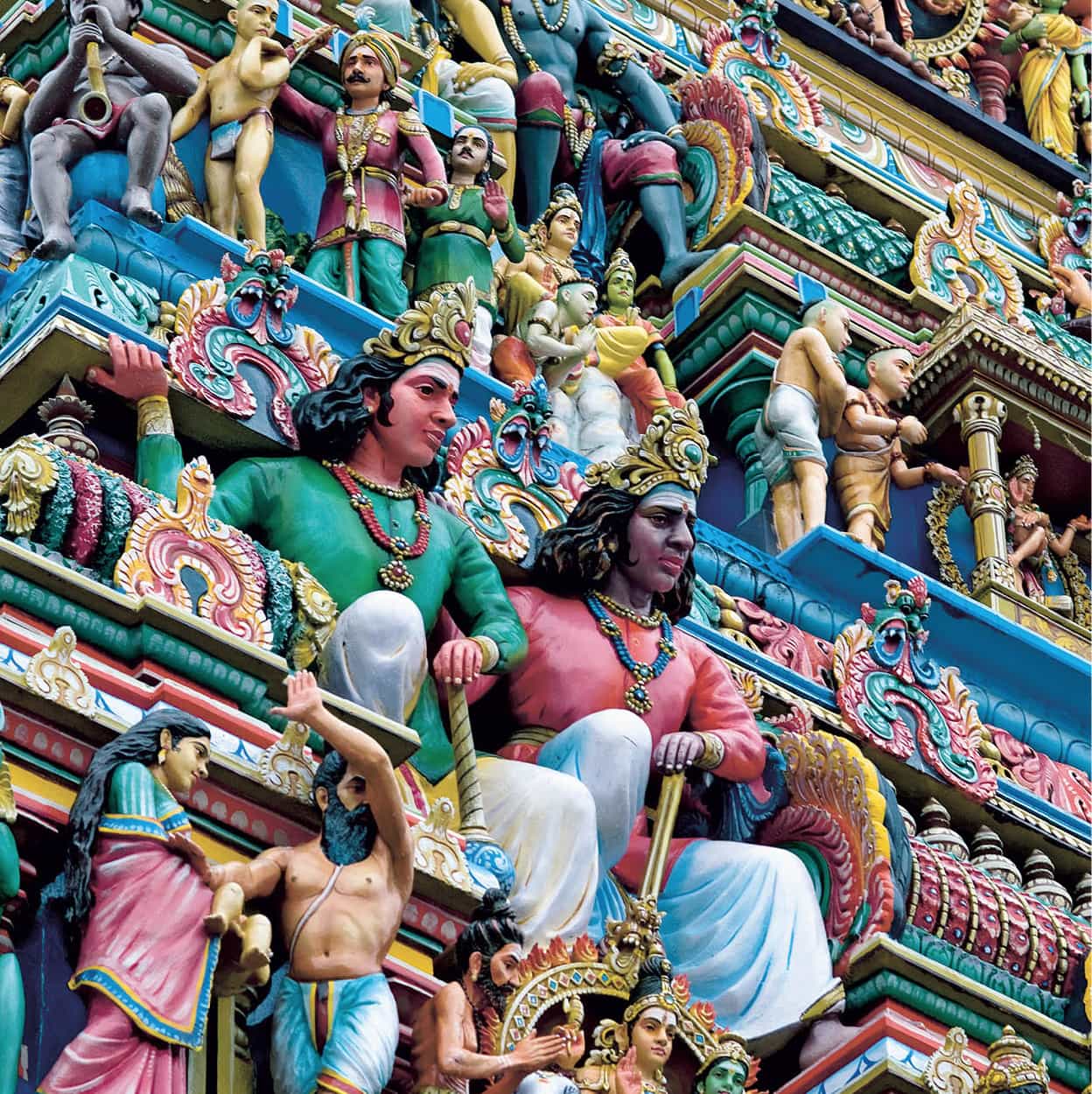
Gopuram detail at Kapalesvara Shiva Temple.
Britta Jaschinski/Apa Publications
North of both Egmore and Fort St George is the district of George Town. Now quite run-down, its tightly packed grid of streets is nonetheless worth exploring. Within this trading district are some of the oldest temples and mosques of British Chennai and the churches of the first Protestant missionaries. The twin Chennakesavara and Chennammallikesvara temples, and the beautifully maintained Armenian Church, are among the most interesting places of worship in the city.
Mylapore
One of the most interesting parts of Chennai lies just south of the city centre. This is Mylapore, with a tank, market area and old Brahman houses. At the evening bazaar, crowds of people, freshly bathed, make their way to the Kapalesvara Shiva Temple G [map] (www.mylaikapaleeswarar.tnhrce.in). The vibrantly colourful sculptures inside and all over its towering gopuram (temple tower) are among the most spectacular sights in Chennai. The temple is dedicated to Shiva in the form of a peacock (mayil) from which the town receives its name (mayil-puram, ‘peacock town’, which became Mylapore). The central shrine (closed to non-Hindus) has a Shiva lingam, behind which is the large temple tank. Timings can be sporadic – afternoon is the best bet. Almost as old is the Krishna Paratasaraty Temple on Triplicane High Road further to the north.
Mylapore is well known for its jewellers, who specialise in making gold-plated ‘dance jewellery sets’. Silver ornaments are dipped into a gold solution, and bright-pink tissue paper is then placed into pre-moulded grooves before being capped with a pale pink stone. The result mimics the ruby-studded gold traditional patterns required for classical dance. The classic headpiece comprises a rakodi, worn just above the flowers in the hair, flanked by a stylised sun and moon. Ear ornaments come in three parts: a chain, a dangler, and a support for the lobe. Around the neck is a choker, plus a half-moon-shaped pendant (padakkam) suspended from a longer chain. A vanki bracelet grips the upper arm and is heavier than the standard gold bangles jingling at the wrist. A broad ornamental belt, called an odyanan, completes the costume. Sometimes a sarpam hair ornament snakes around the long plait for a final golden touch.
Eat
The drink of the south is coffee, rather than tea, and there are innumerable small places serving frothy, milky coffee in small stainless steel cups. Recently, Western-style coffee chains have started to appear, the two most widespread being Barista Lavazza and Café Coffee Day, which both have branches dotted around the city.
San Thome and Adyar
On the coast to the east of Mylapore lies the district of San Thome, named after the St Thomas the Apostle. San Thome Basilica H [map] is on the Main Beach Road: it is believed that Thomas was martyred on what is called St Thomas’s Mount and that his remains were enshrined in this church. The modern crypt marks where he is thought to have been buried and is an important pilgrimage spot for Indian Christians.
The Theosophical Society (www.ts-adyar.org; Mon–Sat 8.30–10am, 2–4pm) has its headquarters on the banks of the Adyar River south of Mylapore. It houses a vast library of books on religion; in the gardens that lead up to the river and the sea is a sprawling banyan tree, said to be one of the largest in India.
Chennai transport
Chennai’s metro (https://chennaimetrorail.org/), a massive $2.7 billion project inaugurated in June 2015, has two lines open, each with 17 stations. The completion of the two lines in 2019 – covering a distance of 45km (28 miles) and including 42 stations – has transformed travel in the city, which was previously bedevilled by the usual Indian traffic nightmares. A further three lines are planned. There is also a serviceable suburban railway, albeit one that’s of little use to foreign visitors as its lines do not run near the major sights. Buses are cheap and crowded.
Taxis are difficult to flag down on the streets and it is best to make arrangements with your hotel if you’re planning a day trip. For short hops, most people generally use autorickshaws. Chennai rickshaw drivers are well known for driving a hard bargain (and will generally refuse to use the meter).
Local attractions
The places described below are easily reached by bus from Chennai’s new, and very well-organised, Puratchi Thalaivar Dr MGR Bus Stand, which lies in the west of the city at Koyambedu.
Tip
Try to catch a Bharata-natyam performance while you’re in Chennai, a contemporary interpretation of one of South Asia’s oldest dance traditions. The dancers once came from a highly trained community of temple dancers, known as devadasis or ‘servants of god’, but are now mostly from urban middle-class backgrounds.
South of the city in Thiruvanmiyur is Kalakshetra, an academy of music and dance set up by Rukmini Devi, the doyenne of Indian dance. Her efforts to re-establish temple dance after it had been banned led to the creation of Bharatya-natyam, now India’s most prominent classical dance form. The academy organises dance programmes.
On the East Coast Road (ECR) south of Chennai is Cholamandalam, the artists’ village, where exhibitions, poetry readings and other programmes take place. At Muttukkadu, 28km (17 miles) from Chennai, is Dakshina Chitra (www.dakshinachitra.net; Wed–Mon 10am–6pm). This is an exemplary museum featuring a number of rescued examples of South Indian village architecture. It aims to preserve and promote traditional crafts.
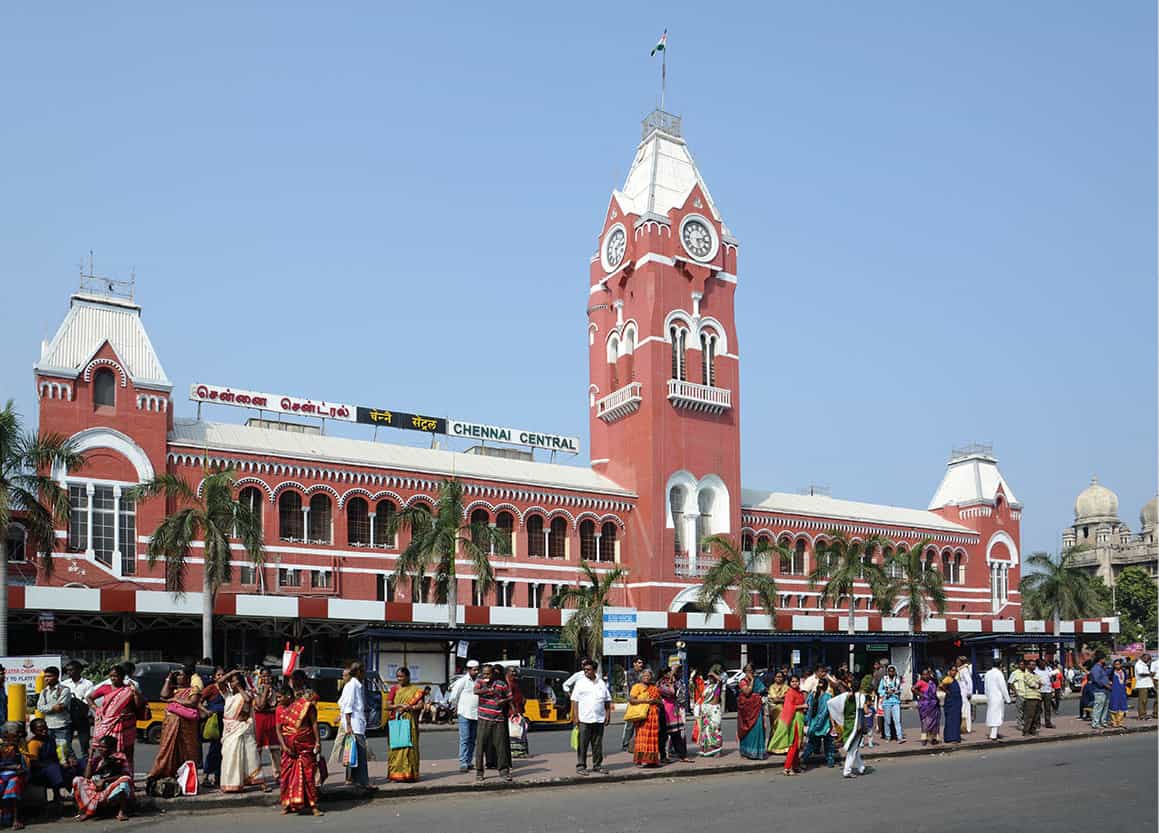
Indo-Saracenic architecture near Egmore Railway Station.
Shutterstock
Outdoors, the attractions in the area immediately south of Chennai include the Guindy Deer Park (Wed–Mon 9am–6pm) and the Chennai Snake Park (www.chennaisnakepark.org; Wed–Mon 9am–5.30pm; no bags allowed inside). The former has species of black buck, chital (spotted deer) and numerous monkeys. The Snake Park is the only major reptilium in India, founded by the American conservationist Romulus Whitaker. Beside the Deer Park is the large campus of Chennai’s branch of IIT (the Indian Institute of Technology). These are the most prestigious science universities in the country, and competition for admission to the courses is extremely fierce. Continuing south down the coast you’ll come to Madras Crocodile Bank Trust and Centre for Herpetology (www.madrascrocodilebank.org; Tue–Sun 9am–5.30pm), an incredibly large collection of different varieties of crocodiles, well worth a visit.
